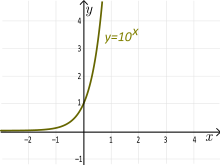Injective function

|
| Injection. Maximum one arrow to each element in the codomain B (from an element in domain A). |
In mathematics, a injective function is a function f : A → B with the following property: for every element b in the codomain B, there is at most one element a in the domain A such that f(a)=b, or equivalently, distinct elements in the domain map to distinct elements in the codomain.[1][2][3]
The term injection and the related terms surjection and bijection were introduced by Nicholas Bourbaki.[4] In the 1930s, he and a group of other mathematicians published a series of books on modern advanced mathematics.
An injective function is often called a 1-1 (read "one-to-one") function. However, this is to be distinguished from a 1-1 correspondence, which is a bijective function (both injective and surjective).[5]

|
| Not an injection. Two elements {X} and {Y} in the domain A are mapped to the same element {1} in the codomain B. |
Basic properties
Formally:
- is an injective function if or equivalently
- is an injective function if [2]
The element is called a pre-image of the element if . Injections have one or none pre-images for every element b in B.
Cardinality
Cardinality is the number of elements in a set. The cardinality of A={X,Y,Z,W} is 4. This is written as #A=4.[6]
If the cardinality of the codomain is less than the cardinality of the domain, then the function cannot be an injection. For example, there is no injection from 6 elements to 5 elements, since it is impossible to map 6 elements to 5 elements without a duplicate.
Examples
Elementary functions
Let f(x):ℝ→ℝ be a real-valued function y=f(x) of a real-valued argument x. (This means both the input and output are real numbers.)
- Graphic meaning: The function f is an injection if every horizontal line intersects the graph of f in at most one point.
- Algebraic meaning: The function f is an injection if f(xo)=f(x1) means xo=x1.
Example: The linear function of a slanted line is 1-1. That is, y=ax+b where a≠0 is an injection. (It is also a surjection and thus a bijection.)
- Proof: Let xo and x1 be real numbers. Suppose the line maps these two x-values to the same y-value. This means a·xo+b=a·x1+b. Subtract b from both sides. We get a·xo=a·x1. Now divide both sides by a (remember a≠0). We get xo=x1. So we have proved the formal definition and the function y=ax+b where a≠0 is an injection.
Example: The polynomial function of third degree: f(x)=x3 is an injection. However, the polynomial function of third degree: f(x)=x3 –3x is not an injection.
- Discussion 1: Any horizontal line intersects the graph of
f(x)=x3 exactly once. (Also, it is a surjection.)
- Discussion 2. Any horizontal line between y=-2 and y=2 intersects the graph in three points so this function is not an injection. (However, it is a surjection.)
Example: The quadratic function f(x) = x2 is not an injection.
- Discussion: Any horizontal line y=c where c>0 intersects the graph in two points. So this function is not an injection. (Also, it is not a surjection.)
Note: One can make a non-injective function into an injective function by eliminating part of the domain. We call this restricting the domain. For example, restrict the domain of f(x)=x² to non-negative numbers (positive numbers and zero). Define
- where
This function is now an injection. (See also restriction of a function.)
Example: The exponential function f(x) = 10x is an injection. (However, it is not a surjection.)
- Discussion: Any horizontal line intersects the graph in at most one point. The horizontal lines y=c where c>0 cut it in exactly one point. The horizontal lines y=c where c≤0 do not cut the graph at any point.
Note: The fact that an exponential function is injective can be used in calculations.
- Example:
Other examples
Example: The logarithmic function base 10 f(x):(0,+∞)→ℝ defined by f(x)=log(x) or y=log10(x) is an injection (and a surjection). (This is the inverse function of 10x.)
Example: The function f:ℕ→ℕ that maps every natural number n to 2n is an injection. Every even number has exactly one pre-image. Every odd number has no pre-image.
Related pages
References
- ↑ "The Definitive Glossary of Higher Mathematical Jargon". Math Vault. 2019-08-01. Retrieved 2020-09-08.
- ↑ 2.0 2.1 Weisstein, Eric W. "Injection". mathworld.wolfram.com. Retrieved 2020-09-08.
- ↑ C.Clapham, J.Nicholson (2009). "Oxford Concise Dictionary of Mathematics, Onto Mapping" (PDF). Addison-Wesley. p. 568. Retrieved 2014-01-01.
- ↑ Miller, Jeff (2010). "Earliest Uses of Some of the Words of Mathematics". Tripod. Retrieved 2014-02-01.
- ↑ Weisstein, Eric W. "One-to-One". mathworld.wolfram.com. Retrieved 2020-09-08.
- ↑ Tanton, James (2005). Encyclopedia of Mathematics, Cardinality. Facts on File, New York. p. 60. ISBN 0-8160-5124-0. (in English)
Other websites
- "Injective, Surjective, Bijective". Mathsisfun. 2013. Retrieved 2013-12-01. interactive quiz
- "Injectivity, Surjectivity". Wolfram alpha. Archived from the original on 2013-11-25. Retrieved 2013-12-01. interactive















